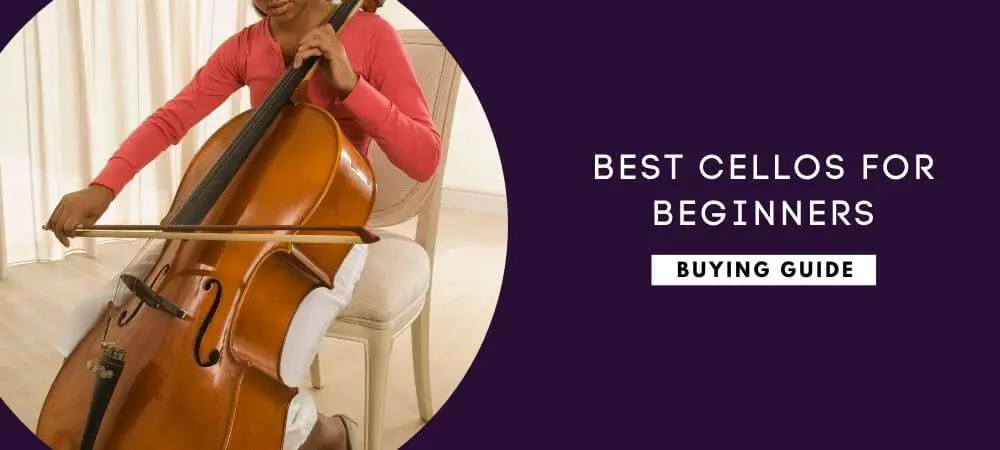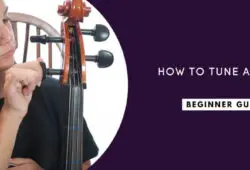A cello is a costly investment, so it makes sense to be a little nervous while shopping for your first cello as a beginner player.
This doesn’t have to be as complicated or high-stakes as you are making it out to be.
Yes, there is a lot on the line.
But don’t worry. This guide will help you find the best student cello that is right for you.
Let’s dive in!
Table of Contents
Quick Summary
- If you are looking for the best beginner cello kit that comes with all necessary accessories, we recommend D’Luca MC100 Meister Student Cello.
- For beginners looking for an electric cello on which they can practice quietly, we recommend the Cecilio CECO-1BK Electric Cello.
- For kids, we recommend the Cremona SC 165 Premier Student Cello.
- If you are an adult beginner looking for a premium cello to get started on, check out the Cecilio CCO-500.
Best Cello For Beginners In 2024
1. Cecilio CCO-100 Student Cello, 4/4 Review
The Cecilio CCO-100 is a cello starter kit that comes with everything you need to learn to play the cello.
It comes with a soft padded case, a Brazilwood bow, rosin cake, a cello stand, and an extra set of strings.
These accessories aren’t necessarily of the highest quality. However, they will set you up sufficiently, helping you save some money down the road.
This quality cello has a crack-proof spruce top and maple neck, sides, and back, complete with a beautiful natural varnish finish.
The hardy spruce top is resistant to scratching, bumping, or any other type of damage. This enhances the durability of your instrument, which is just what you want in a beginner cello.
The maple neck, sides, and back are great for tone quality, and the fingerboard is similarly made from maple.
- Incredibly affordable.
- Complete kit of accessories.
- It is made from quality tonewoods.
- The strings will need replacing.
2. Lykos Acoustic Cello, 4/4 Review
Another student cello, this Lykos cello, would be perfect for a beginner player looking for a decent quality instrument at a reasonable price.
The instrument comes with a crack-proof maple spruce top and what this simply means is that it’s composed of laminated sheets of wood that guarantee the cello’s durability.
The sides and back of this instrument are made from basswood, while the fingerboard is made from solid wood.
The tailpiece of this cello is of excellent quality, made from aluminum alloy.
You don’t always expect a great tone from beginner cellos, but this is an exception. For a beginner instrument, the tone quality of this cello is pretty impressive.
This full-size cello outfit comes complete with a padded gig bag, an Arbor bow, and rosin.
- Features a beautiful finish.
- Lovely tone.
- Durable top design.
- The tuning pegs need a little “breaking in.”
3. Cecilio CCO-500, 4/4 Review
The Cecilio CCO-500 looks absolutely elegant, with its high-luster varnish and beautiful inlaid purfling.
This high-quality cello would be ideal for beginner and intermediate players, and it boasts superior construction to match that.
First off, the solid spruce top is hand-carved, while the maple neck, sides, and back are beautifully flamed, speaking of the instrument’s quality.
This cello has an ebony fingerboard, which is the standard on all high-quality cellos.
The mother of pearl inlaid tailpiece beautifully complements the nickel-plated fine tuners.
The cello comes complete with a hard and soft case, a cello stand, a Brazilwood bow, rosin, and an extra set of strings. Better yet, the bow comes with unbleached, genuine Mongolian horsehair, so you know this beginner cello is of premium quality.
- Excellent value for money.
- It is made from high-quality materials.
- 1-year warranty.
- It might require a few adjustments during setup.
4. Cremona SC 165 Premier Student Cello, 1/4 Review
Cremona is a renowned cello brand whose instruments are famed for their superior sound quality.
The first thing you will notice about this student cello is its incredible sound projection for its size.
As a result, the tone is much deeper and warmer than what you’d expect from a 1/4 size cello.
The instrument has been crafted from the finest hand-carved solid spruce and maple, which delivers fine tone quality.
In addition to that, you have an ebony fingerboard and Indian rosewood fittings.
At the same time, the easy playability of this beginner cello means that dedicated students will be able to progress rapidly, making them even better cellists.
The cello comes with a hard shell foam case and a bow
This instrument is bound to suit beginners, intermediate players, and advanced players alike.
- Features quality craftsmanship from quality tonewoods.
- Excellent sound projection.
- Comfortable to play.
- None.
5. D’Luca MC100 Meister Student Cello Review
This D’Luca cello outfit is among the student cellos that provide the beginner player with everything they will need to get started on the cello.
It includes a portable cello stand, a padded gig bag, extra strings, a clip-on chromatic tuner, rosin cake, and a high-quality horsehair bow.
The portable stand is a handy addition that will make it even easier to play your instrument.
Additionally, the chromatic tuner will make your tuning experience that much easier, not to mention eliminating the need for you to buy a separate tuner.
Featuring a maple top, back, and sides, this cello has rosewood fingerboard and pegs and a high-quality maple bridge which gives a gorgeous tone.
- Great value for money.
- Beautiful-looking cello.
- Decent sound.
- The wood isn’t of the highest quality.
6. Cecilio CECO-1BK Electric Cello Review
There are many reasons why players may wish to have an electric cello, and if you are looking for one, you cannot go wrong with the Cecilio Ceco-1BK.
The best part about electric cello outfits is that you can listen to your performance through the earphones, allowing you to practice freely without disturbing others. More so if you will be playing well into the night.
This elegant electric cello is hand carved from solid maple wood and features an ebony fingerboard and pegs, along with a beautiful mother of pearl inlaid tailpiece.
The tuning pegs are detachable, and many advanced players prefer to take these off.
This instrument comes with a 9V Alkaline battery for amplified playing, which powers the cello. Additionally, you get a well-padded soft case, a bow, rosin cake, an aux cable, and headphones.
- Stylish design and sturdy build quality.
- Can play silently.
- 1-year warranty.
- Low-quality headphones.
7. Cremona SC-130 Premier Novice Cello Review
The best cellos are supposed to be lightweight because good luthier wood has dried over many years before finally being used to make an instrument.
As such, the lightweight feel of this particular Cremona cello speaks volumes of its quality.
Made from solid tonewoods, this cello has been hand carved with the finest quality craftsmanship to deliver the finest possible sound.
This cello’s body’s quality is remarkable for an instrument in this price range, and the Ebony fittings are an added advantage.
The strings are perfectly spaced for accurate finger positioning and optimum intonation. Additionally, the oiled neck gives the instrument a better feel and balances the bow better for more effortless playing.
The Swiss-style tuning pegs have been properly fitted, guaranteeing that they work efficiently and hold tune very well.
- It is built from quality materials.
- Sounds beautiful.
- Comfortable to play.
- You’ll need to replace the strings.
How Do I Choose A Cello For A Beginner?
Cello Size
| Cello Size | Cello Length | Age Range |
| 1/10 | 29.5 inches | 4-5 years |
| 1/8 | 33.5 inches | 5-6 years |
| 1/4 | 38.5 inches | 6-7 years |
| 1/2 | 42 inches | 8-10 years |
| 3/4 | 45 inches | 11-14 years |
| 4/4 | 48 inches | 15 years and above |
All these sizes are meant to cater to players of different heights and ages, and it is always advisable to size a cello correctly to the intended player. This sizing can be done with the help of a cello instructor or a knowledgeable music store attendant.
Most players gravitate towards the 3/4 size cello because it offers the best comfort and ease of playing for petite teens and adults alike.
Comfort
Ultimately, a cellist needs to be able to reach the necessary hand and finger positions for accurate bowing while they play the cello.
How can you tell that a cello is perfectly sized for your body proportions?
The perfect beginner cello should allow you to sit up in a chair with your knees bent at a 90-degree angle and your feet flat on the floor while you’ve extended the cello endpin. Let the top of the cello’s body rest against your chest, with the neck and scroll to the left of your head.
The lowest tuning peg, which is the C peg, should be near your ear, and using your left hand, between your first and fourth fingers, you should be able to comfortably span the interval of a minor third, which is two half steps.
Craftsmanship
a) Purfling
Is the purfling made of genuine inlays, or has it been painted on?
This is often one of the distinguishing factors between a good quality cello and an inferior quality one. Genuine inlaid purfling typically comprises three layers: regular wood sandwiched between two layers of blackwood.
Visually, you can spot genuine purfling because the wood in the purfling will have a different grain orientation from the table or back wood.
On the other hand, low-quality cello brands will have fake purfling that’s often painted on, and the direction of the wood grain inside the purfling will be similar to that outside the purfling.
b) Varnish
Good varnish is essential to a cello’s aesthetic appeal and structural identity.
The wood and varnish will change over time as you keep playing the instrument, enhancing the cello’s reverberation and ringing quality. When this happens, it is often said that the instrument is “opening up” sonically, and you can actually hear the sound difference as these changes occur.
Heavily applied varnish can prevent your cello from “opening up,” causing it to resonate less and less as you play.
The best cello brands use a varnish that’s soft enough to allow the instrument to vibrate freely when played, thereby enhancing its sound quality. It should almost act as a living, breathing skin, moving and evolving with the cello throughout its life.
Quality Of Wood
One way to identify whether your instrument is made using laminated wood would be by checking the edges of the F-holes to spot the layered cross-section. Unfortunately, although it may be highly durable, laminated wood does not give the best sound.
Besides that, you can also judge the quality of wood used by checking for the “flame.”
The flame refers to the horizontal streaks of contrasting color found below the varnish within the wood itself. As a rule of thumb, the more densely flamed the instrument’s back, sides, and neck, the more expensive the wood used to construct the cello.
Try and steer clear of cellos that use plain wood for their backing as much as you can. At the same time, be on the lookout for artificially created flames. Real flames are iridescent, which means that the dark streaks become light and the light streaks become dark as you move the instrument.
Musical Qualities
Many times, music shops will have quiet rooms for playing instruments. Or even the music shop might be gracious enough to let you take your preferred cello home for a test drive before you purchase it.
If you have been able to negotiate for a take-home trial period, be sure to play the new cello in various settings. Play it at an orchestral rehearsal, in your school hall, in church, or wherever else you perform. The idea is to try out different venues because your instrument is bound to sound different in other settings.
This will allow you to better judge how the cello responds and blends in small rooms and large halls alike.
How do you go about testing the aural qualities of your new cello?
Start by playing each of the four open strings, giving each string a couple of full bows. This will help you establish the tension of the strings and determine whether your new instrument works best with a lighter bow stroke or a heavier one.
Secondly, play any of the major scales just back and forth. This will help you establish whether the strings are well balanced. There shouldn’t be any noticeable change in sound and timbre when playing a melody across two strings. The only audible difference should be the frequency of the notes being played.
Lastly, play one long note on each string, and this will help you see how well the instrument sustains.
While testing out your new cello, the idea is to utilize all strings and try using multiple playing positions. Listen for the instrument’s volume and projection while you play. Can the cello maintain a wide dynamic range in all registers and in first and upper positions?
Get as many people as you can to listen to your playing. Besides just sounding good under your ear, the cello ought to sound good across the room and even at the very back of the concert hall.
Playability
The best beginner cello should be comfortable to play, with responsive strings and comfortable action.
Under your command, an instrument that’s easy to play should vary smoothly in volume, pitch, and tone. The notes should be where you expect them to be, whereas the pegs and tuners should work smoothly, holding the tune well.
Even for the utter beginner, the cello as a whole ought to feel comfortable and responsive under your bow and fingers. You should be able to play it without much effort and without feeling like the strings are cutting into your fingertips.
Cellos For Beginners FAQs
What Is The Best Beginner Cello To Buy?
The best beginner cello to buy based on the reviews above is the D’Luca MC100 Meister Student Cello.
As with many stringed instruments, the cello is almost an extension of the person playing it, and when in action, the player and their instrument work harmoniously as one.
That being said, finding the perfect cello, or rather, the best beginner cello is a highly subjective matter driven almost by one’s gut feeling rather than by logic and reason.
Does the instrument sound right to you? Does the cello feel good under your bow and fingers? If so, then trust your instincts because chances are you may have found your perfect match.
What Is The Best Size Cello For A Beginner?
The ideal cello size for a particular player will depend on the player’s age, height, arm length, and finger span. That being said, the best cello size for a beginner is one that the player can comfortably hold, getting their arms around it and keeping it stable while they play.
While seated upright on a chair with your feet flat on the floor, your cello should lean slightly to the left, resting easily on your left upper torso. The C-string peg should be near your head, behind your left ear, and there should be some space between your neck and the cello’s neck. Your knees should gently balance but not hold the instrument.
If you can maintain this position, you are using the right cello size. If not, try adjusting your endpin to ensure it is around 12 inches in length. If that still doesn’t work, you will need to size your cello up or down accordingly.
If you are in between cello sizes, you are more likely to be comfortable with the smaller-sized cello.
How Much Does A Decent Beginner Cello Cost?
A decent beginner cello costs between $800 and $1,500. This is the amount you should expect to pay for an instrument that’s s well crafted, sounds good, and is easy to play.
Conclusion
Buying a cello is a highly subjective endeavor. Rather than being an exact science that depends on logic and sound reason, selecting the best cellos for beginners is more about finding what sounds and feels right to you.
So always trust your gut. You’d be surprised at how many beginner players can actually tell an excellent-sounding cello apart from a terrible, inferior quality cello.
If the instrument looks good, sounds right to you, and feels right under your fingers and bow, then look no further – you have just found your perfect match.












